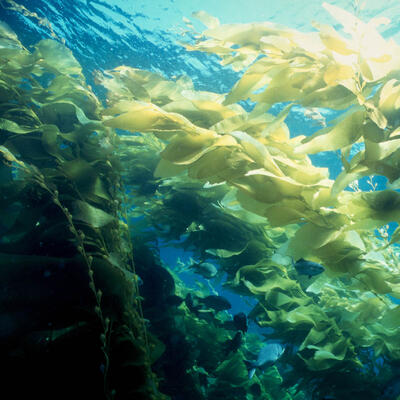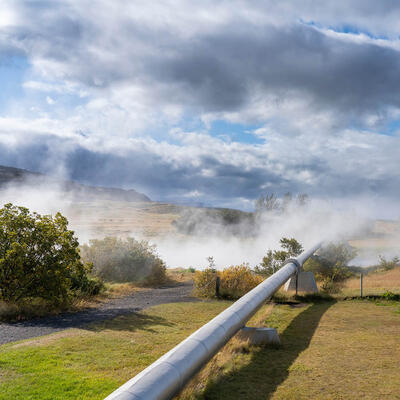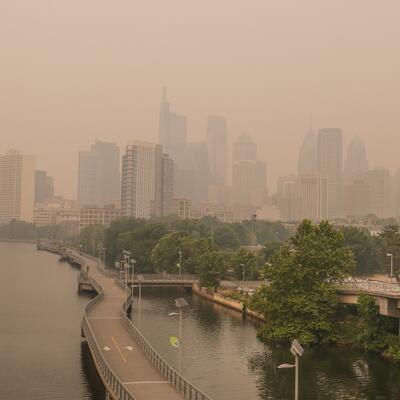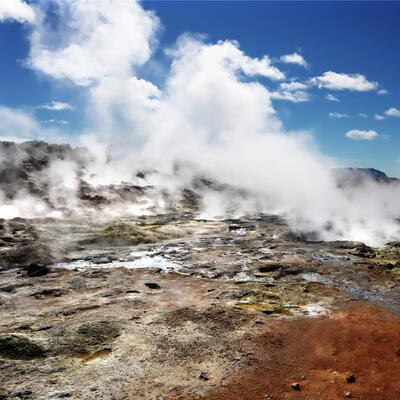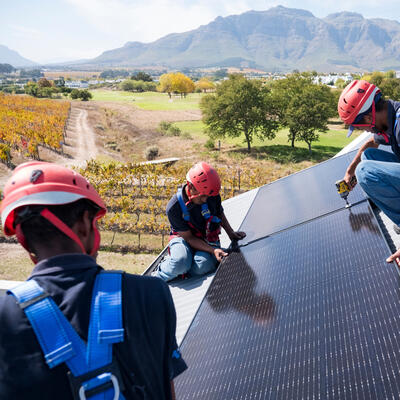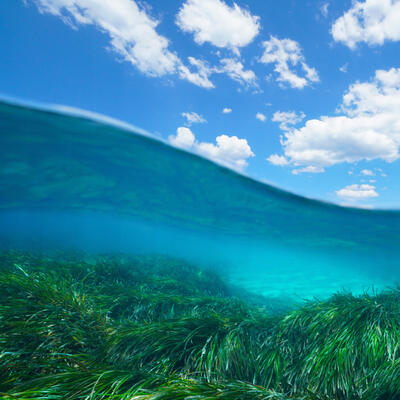
Blue Carbon: Sinking It in the Sea
Guests
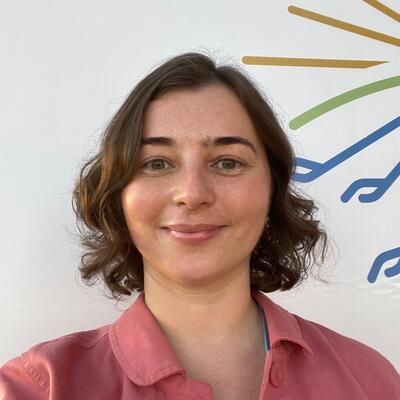
Irina Fedorenko-Aula

Isabella Masinde

Emily Pidgeon

Ralph Chami
Summary
When most of us think about using nature to remove carbon dioxide from the air, we think of trees. Yet blue carbon, a new name for storing carbon dioxide in coastal and marine ecosystems where it can no longer trap heat in our atmosphere, may have even greater potential. Salt marshes and mangroves have carbon-capturing capacity that may surpass that of terrestrial forests and they are found on every continent except Antarctica. Emily Pidgeon, Vice President of Ocean Science and Innovation at Conservation International explains, “In some cases these ecosystems can have up to four or five times more carbon on a per unit area than we see in some of the ecosystems that we traditionally think of as being carbon rich, like the forests of the Amazon or other carbon rich terrestrial ecosystems.”
The efficient sequestration of carbon can also make the loss of the coastal ecosystems especially devastating for the climate. At least half of the world's mangroves and a third of the world’s salt marshes have been lost. Seagrasses, for example, currently cover less than 0.2% of the ocean floor, but store about 10% of the carbon buried in the oceans each year. When those ecosystems are lost, they release that sequestered carbon dioxide back into the atmosphere. Pigeon says, “Actions on a small area can have a disproportionately large impact from a climate mitigation point of view.”
One way to incentivise preservation of these ecosystems is by assigning monetary value to them. That’s exactly what Ralph Chami of the International Monetary Fund advocates. After learning about whales’ role in oceanic carbon cycles, he observed, “Here's a whale and it’s providing a carbon sequestration service on behalf of humanity. If she could speak our language, what would be the wage that she would demand? He did the math and pegs the value of each whale’s carbon services over its lifetime at around $3 million.
Chami also applied a calculation to the value of seagrass and came to a staggering figure. “If you were to use the average price of carbon of last year, which is about $60, the total value of carbon services of seagrass is over $2 trillion. Not billion. Trillion.”
The importance of these coastal ecosystems stretch beyond their climate benefits. For example, mangroves are an integral part of many communities. Vlinder is a firm aiming to help companies achieve their net-zero goals by developing mangrove restoration projects. Their Founder and Co-CEO, Irina Fedorenko-Aula, explains, “It’s about protecting people from sometimes very violent, extreme weather events. Having the healthy mangrove forest in front of the villages is literally a question of life and death.”
Mangrove restoration projects also provide economic opportunities to communities that often have few. Fedorenko Aula elaborates, “You basically have regions that are usually poor and usually depressed and usually struggle from unemployment. And suddenly, you have investment that creates a lot of jobs.”
It’s one thing to propose an ecosystem restoration project; it’s another to actually implement it. From making sure the community is on board to getting the right materials to the right place at the right time of year, there is no shortage of challenges. But Isabella Masinde, CEO of Umita, a project management company in Kenya, says that when one community sees how their neighbors are benefiting, they are quickly persuaded. Masinde describes how one community reacted when they saw satellite pictures of degraded parts of the mangrove forest, “We are going to be finished if we don’t have this ecosystem restored.”
Episode Highlights
06:28 Emily Pidgeon "Terrestrial forests often reach maturity and at that point reach the sort of equilibrium in the atmosphere, these ecosystems, if they're healthy, continue forever to sequester carbon."
24:48 Ralph Chami "The Bahamas is sitting 20% of the total known seagrass in the world. What does that mean for The Bahamas? That potentially The Bahamas is sitting on about 400 billion of wealth?"
28:59 Ralph Chami "How much time do we have to dismantle and rebuild the new system? Titanic is sinking and you're telling me what if the Titanic didn't sink well, wouldn't be having this conversation. We'd be dancing in the ballroom and the orchestra is playing, but right now everybody has to get together to fix a problem."
31:55 Irina Fedorenko-Aula "It's not just about sequestering Carbon it's about protecting people from sometimes very violent extreme weather events and for people who live there, having a healthy mangrove forest in front of their villages is literally a question of life and death."
Resources From This Episode (3)
Full Transcript
Note: Transcripts are generated using a combination of automated software and human transcribers, and may contain errors. Please check the actual audio before quoting it.
Greg Dalton: This is Climate One. I’m Greg Dalton. Blue carbon is a new name for carbon dioxide stored in coastal and marine ecosystems. Through the use of carbon markets, it could be a key tool for stabilizing the climate that sustains our lives and economy.
Ralph Chami: If you were to use the average price of carbon of last year which is about $60, the total value of carbon services of seagrass is over $2 trillion. Not billion, trillion.
Greg Dalton: Many of the opportunities for blue carbon markets are located in developing countries along the equator.
Ralph Chami: If I am sitting on seagrass, I can sell the carbon sequestration services of my seagrass.
Greg Dalton: Funding those carbon sinks reduces global emissions, and benefits communities on the ground too.
Irina Fedorenko-Aula: It’s about protecting people from sometimes very violent, extreme weather events. Having the healthy mangrove forest in front of the villages is literally a question of life and death.
Greg Dalton: Blue Carbon: Sinking it in The Sea. Up next on Climate One.
Greg Dalton: This is Climate One. I’m Greg Dalton.
Many of us think of trees when we talk about carbon sequestration, or storing carbon dioxide where it can no longer trap heat in our atmosphere. Yet “blue carbon” may have even greater sequestration potential. Coastal ecosystems such as salt marshes and mangroves, have carbon-capturing capacity that may surpass that of terrestrial forests. Seagrasses, for example, currently cover less than 0.2% of the ocean floor, but store about 10% of the carbon buried in the oceans each year.
Emily Pidgeon is Vice President of Ocean Science and Innovation at Conservation International. She says just like the Amazon rainforest, preserving and restoring coastal ecosystems is critical for drawing down atmospheric carbon.
Emily Pidgeon: Mangroves, seagrasses, and salt marshes are found on every continent except Antarctica. And what's special about these ecosystems is that they remove carbon from the atmosphere and the ocean and then bury it for millennia in the soils below them. And so because they've been doing that amazing process of removing the carbon from the ocean and the atmosphere and burying it for such long periods of time, they end up with very large, very deep deposits of sticky, carbon rich soil below them. And so in some cases these ecosystems can have up to four or five times more carbon on a per unit area than we see in some of the ecosystems that we traditionally think of as being carbon rich, like the forests of the Amazon or other carbon rich terrestrial ecosystems.
Greg Dalton: So then what's the potential if these very rich mechanisms for capturing carbon from the air and putting it into the ground, underwater what's the potential for increasing carbon storage? How big a lever is this?
Emily Pidgeon: So we know these ecosystems are incredibly carbon rich. And so we also know that we've lost at least half of the world's mangroves, probably about a third of the world's salt marsh. And quite frankly, we don't really know how much of the seagrass is lost cause we don't really know what the total area is. But, this represents a really huge opportunity, I guess, to return these ecosystems, to restore them to then become the machines that they are at removing carbon out of the atmosphere in the ocean. At the same time, we know these ecosystems have very rich carbon stores in them. And the ongoing loss that we see of these ecosystems due to coastal development, due to water, coastal water pollution and agriculture, is also a really important action we need to take to make sure that the carbon that's stored in there isn't then emitted as a result of the conversion. Recent studies have shown us that, while, these ecosystems represent about 2% of the terrestrial forests, that ongoing losses of them could account for up to 10% of the emissions from forest loss. And so they're sort of a small, very rich ecosystem that actions on a small area can have a disproportionately large impact from a climate mitigation point of view.
Greg Dalton: And when most people think of nature-based solutions, they tend to picture land-based solutions like planting trees. We hear Jane Goodall and trillion trees. There's lots of talk about trees. Why don't these blue carbon solutions get more attention?
Emily Pidgeon: I think that the understanding of the importance of these ecosystems as carbon mitigation really only emerged, out of the scientific literature about 10 years ago. and in that 10 years, it's taken some time to get the attention, for instance, of the IPCC, the Intergovernmental Panel on Climate Change, which is the scientific group that really oversees the state of knowledge when it comes to climate change, these ecosystems were included in guidelines by the IPCC in 2013, and that was really the first, acknowledgement, within the climate discussions of these ecosystems. Mangroves were explicitly mentioned in the Paris Climate Accord, which was wonderful. But again, it was a sort of small mention and it took some time for countries to really understand how important these ecosystems are. But, we now have at least 40 countries, including these ecosystems, actions associated with these ecosystems to how they're gonna make their commitments to achieving the Paris Climate Accord, which is wonderful to see that happening. But it also, considering that, uh, these ecosystems are on every coastline, except Antarctica also shows you the opportunity for other countries to step up and do the same.
Greg Dalton: So we've talked about where these opportunities are, the scale,How, what's the timeframe we're talking about? How fast can these coastal ecosystems draw down carbon compared to land-based forests?
Emily Pidgeon: If we are thinking about them in terms of their capacity to remove carbon dioxide from the atmosphere and from the ocean, they're probably very comparable, like restoring a mangrove system with restoring a, uh, terrestrial forest from scratch. The thing that's amazing about these ecosystems, however, is that capacity, that, that ongoing sequestration pretty much, continues, forever ad infinitum. And so, whereas terrestrial forests often reach maturity and,at that point, reach the sort of equilibrium in the atmosphere, these ecosystems, if they're healthy,continue.forever to sequester carbon. And so that's why we end up with these enormous carbon deposits underneath them. Is there, if you like, a history going down of the carbon laid down year after year after year. I think one of the most important things we should be doing, however, is really remembering that these ecosystems, like, like the terrestrial ecosystems, have these amazing carbon stores, and when we degrade them or, or destroy them, that carbon is released into the atmosphere and that's, that's instantaneous. And so there's actions we can be taking today to prevent that.
Greg Dalton: Well, let's dive into mangroves. According to Fair Carbon's John Vermilye, there are only 17 successful mangrove restoration projects in the world. If they're so powerful and effective, acknowledging that it's relatively new, the understanding of the importance of these areas, why are there so few? Why aren't there thousands?
Emily Pidgeon: So, mangrove restoration is one of those things that is easy when you know how to do it. Mangroves are a very picky ecosystem that lives at that really interesting interface between the ocean and the land. they want to be in the ocean water, but they don't wanna be too far into the ocean water. They depend on the shape of the coast and the ocean water that floods them every day with the tides. And so I. That a lot of people originally have been restoring these mangroves as though they were dry land, terrestrial trees. And, we've learned, however, a lot in the last 10 years, that they need to be treated differently and really to pay attention to the landscape around them, such that the success rate for restoring mangroves has increased dramatically in the last five years, such that I think John, who I know and really respect. I think those numbers might be slightly out of date because I think that we've seen success now. We've found in many places that if you restore the shape of the coastline, um, that the mangroves often restore themselves. that they plant themselves back. What we see often when mangroves have been degraded, a common example in Southeast Asia for instance, might be mangroves that have been removed for fish and shrimp ponds. And the act of putting shrimp ponds in so changes what the coastline looks like. That, it's no longer suitable for mangroves to, to. and so that when people try and go restore the mangroves all just die off. So what we've found now is that people go in and actively restore the natural water flow, actively restore the shape of the coastline, that there'll be a sort of off and a natural replanting by the mangroves themselves when you give them the conditions they need to grow.
Greg Dalton: People often ask me for, you know, bright spots, good things that are happening. What you're describing is something that's a very, powerful climate lever that can happen quickly, can happen in lots of places. Mangroves can restore themselves. What are the biggest barriers to this very promising blue carbon solution?
Emily Pidgeon: I think there's so many different pressures on these coastal areas that,finding the places that we can restore them. If we look throughout Southeast Asia, there's large areas of the coast that have been lost to fish ponds, various other agriculture and development. And it's often very challenging, because those developments, that agriculture is somebody's livelihood. And so they're finding that balance and really being able to provide the alternative incomes, alternative livelihoods for people such that we can restore and conserve these critical ecosystems, while also ensuring that the people that depend on these areas are able to thrive is the challenge that we have faced with every day.
Greg Dalton: We hear sometimes other places with kind of energy and food and restoration coexisting. You know, lots of ranchers have wind turbines on their land, that sort of thing. Can shrimping and mangroves peacefully coexist?
Emily Pidgeon: So we are doing that experiment as we speak. So there's a lot of discussion about shrimp being the major driver of mangrove floss, especially as we work in Southeast Asia. Conservation International actually has a project right at the moment, whereby we are looking at working with shrimp farmers, initially in Indonesia, to intensify, a certain fraction of their ponds. So for instance, if you have a large area of, uh, shrimp ponds on the coast, we go and we increase the technology that they have available to them so that they can get more shrimp per area on us. Sort of small fraction of their farm. And then we restore the shrimp areas between those ponds and the coastline. Now that this gives us a number of huge advantages. One, they get more shrimp per area on a smaller area. And that shrimp, because it has an environmental benefit, they end up getting a higher price for their shrimp because we can certify it as being environmentally friendly. then that shrimp ponds itself now have a large area of mangrove between them and the coastline, which has all that carbon value that we were just discussing. It also provides a natural barrier protecting the shrimp from any storms that come through. And it also means that when the outflow from the shrimp actually makes it out to the coastline, it's being cleaned by those mangroves. And so this is potentially a win-win-win on multiple levels. And we're, we're actually trying this as we speak in Indonesia as an experiment.
Greg Dalton: That's fascinating. So that nature and the economy can coexist and that person doesn't face a choice of, you know, my income or that, that mangrove, you know, this is relevant to so many places around the world because most of the world's population lives along coastlines, and we hear elsewhere in this episode from Irina Fedorenko-Aula about the social impact of mangroves. How do you see the community benefits of coastal programs to store carbon in the soil?
Emily Pidgeon: So it is really interesting when you go to the communities, they all know how important the mangroves are. We have a wonderful project, which was one of the first projects to produce carbon credits, using the Verra methodology, on the north coast of Columbia. And if you go and sit with the communities there, they know their mangroves are important. They know their mangroves are critical for their fisheries. They know their mangrove. Critical for protecting their communities. They consider themselves great stewards of the mangroves, but quite frankly, they don't really care about the carbon in the mangroves. So if you think about all the important values of mangroves, um, whether it be biodiversity for supplying fisheries, whether it be timber, or other livelihoods, from a local point of view, the carbon really isn't that.
Greg Dalton: It's an abstraction. It's something far away. You can't see it. It's an abstraction.
Emily Pidgeon: And I think that though, to you and I, as much as we respect those other values, they really aren't that important to you and I sitting where we are. Right? Whether those, and it's the carbon that matters to us. And so to me this is what's distinctly different about the carbon ecosystem services. It's the ecosystem service that value that is valued by everybody else as opposed to the locals. And so it's with that ecosystem service, we can use things like carbon markets and other climate financing approaches to bring resources to the communities on the ground who are actually doing the actions.
Greg Dalton: Emily Pigeon, Vice President of Ocean Science and Innovation at Conservation International. Thanks for sharing your insights on the importance of oceans and mangroves here on Climate One.
Emily Pidgeon: Thank you so much for having me.
Greg Dalton: This is Climate One. I’m Greg Dalton. When it comes to sequestering carbon, one blue whale is worth thousands of trees. That was the finding of economist Ralph Chami of the International Monetary Fund. After a transformational whale-watching trip, he did the math and pegs the value of each whale’s carbon services over its lifetime at around $3 million. In conversation with Ariana Brocious, Ralph recounts that experience while on a research boat in the Gulf of California.
Ralph Chami: On my first outing, first outing, imagine. and a beautiful blue whale just appears next to our boat. You know nothing prepares you for that, nothing. You’re in a 25-foot boat and there's a 110-foot whale just feeding next to you. I remember that moment, it’s like today. I looked at her and I thought what are you how is it that I didn't know you existed? And by the way, you have to understand the blue whale is the largest creature that has ever lived. You can fit an African elephant inside her mouth and would disappear completely. I mean, she could've swallowed us and no one will ever know but she didn't. She fed gracefully around us. I remember having tears in my eyes but I was hiding them because I didn't know anyone. So, that night we were all sitting around the table and we are having wine. And these are whale activists, scientists, and so forth. And they’re all bemoaning the fact that the great whales their numbers have dwindled from over 5 million to about a million and some. But for some species I mean like the Atlantic right whales they’re almost gone to 330 of them left. And I was trying to figure out what do I do? I mean I felt helpless and hopeless. Until they mentioned whale carbon. And what I was interested in because economists and finance people think, on average, how much does a great whale capture carbon on average. I had to calculate it myself. And that's the number now that you see all over the world. People talk about 33 tons. That's basically my number.
Ariana Brocious: And put that number in a context for us. What does that represent when people are thinking about carbon?
Ralph Chami: That represents 1500 trees on the body of a whale. And that whale because they are negatively buoyant because they’re so heavy. When they die, they sink And anything that sinks below a thousand meters is sequestered forever unless you disturb it.
Ariana Brocious: And same with their poop too, right?
Ralph Chami: So, this is where they explained to me that well, the great whales they for the most part, like to eat krill. And krill directly and indirectly feeds on phytoplankton. And phytoplankton are really the lungs of the planet because they're the ones where everything starts really. The biological cycle of the ocean of the water really starts with phyto. Phyto captures about between 33 and 37 gigatons of carbon dioxide from the atmosphere per year. That’s equivalent to the work of four Amazon forests. Okay. So, think of a triangle. The base of that triangle a whale feeds on krill. The krill feeds directly and indirectly on phytoplankton. Now we need an arm, the third arm from the phyto to the whale. And there is which was to my surprise that it's the poop of the whale. It has in it nutrients that fertilizes the phyto. And there's more phyto the productivity increases, meaning they grab even more carbon from the atmosphere. That there is more phyto there’s more krill. More krill more food.
Ariana Brocious: So, whales are in this integrated system. Absorbing carbon and then sequestering it once they die. So, you are an economist, how do you then you have translated this into like a dollar figure. How have you done that with the monetary figure on this?
Ralph Chami: Remember, I'm just part of it. I'm listening to this conversation. And these people are really committed to saving the whales. And all the love of the whales and philanthropy and altruism is not saving them. What else can save them, right? So, I'm sitting there and I thought to myself, well, wait a minute I'm sitting at the IMF. The IMF is looking at climate change. And IMF has identified carbon sequestration, right, we need to reduce our carbon emissions and we need to sequester carbon from the atmosphere and sequester it if we are going to avoid reaching the 1.5°. Okay. And IMF comes out and says the price of carbon ought to be $78 in order for people to change their behavior. So, I'm thinking at this I thought to myself, wait a minute, wait a minute. If the whales are grabbing carbon directly on their body and indirectly through their fertilization. And I knew the estimates vary. But let’s just say on average, what would be the value of that service. So, I said to the scientist I can value the carbon sequestration service of the whales. And they said, for what purpose? So, they’re scientists they don’t think like we do. And I said, think of it this way. I work for the IMF and I provide the service and they pay me a salary. The IMF does not pay me a salary because Ralph is a nice guy nor that Ralph is a husband or a father or a good citizen. They just because I provide a certain service that the IMF is interested in. Do you guys agree? They said yes. Okay, well, here's a whale and it’s providing a carbon sequestration service on behalf of humanity. If she could speak our language what would be the wage that she would demand? That’s it. Because after that people said, oh, you’re pricing a whale. I said, no man, what I’m trying to tell you is the whale, unfortunately, doesn’t speak English, doesn't speak dollars and cents. And so, we've taken them for granted. Well, they are going around helping us fighting climate change. So, if they could speak our language or if we could understand their language they’ll be saying, hey, dude, why don’t you pay me? I’m helping you survive. So, once you put it in that, then you can go out and calculate. Because then the next thing was, well, it’s capturing carbon over our lifetime. It’s like people calculate lifetime earnings of any individual, right? So, you provide a service over your lifetime until you retire. And now what you’re going to do is calculate the expected present value of your lifetime earnings. How much is that service worth?
Ariana Brocious: Yeah, what is it?
Ralph Chami: 2 million. Minimum at the time. Now, it could be 1 million could be 3, but it's not zero. Because up until that work and even today, the world still puts a zero value on the whale despite this work. Because we only had a value for a dead whale. In countries where they still eat whale meat or blubber or use their oil. They kill the whale. They chop it to pieces and they sell it as meat. And suddenly it acquires $40,000. So, there is price in killing a whale but there is no price for a living whale.
Ariana Brocious: So, whales are a fascinating example of this. And you've also began work in different carbon capture sphere of the ocean. So, let's turn to seagrass and using that same methodology how have you been able to value the carbon sequestration services of seagrass?
Ralph Chami: So, this is work with the famous Professor Carlos Duarte who was the father of blue carbon, actually. So, it turns out that seagrass, what we were interested in is what is the value of seagrass globally. And seagrass turns out to live for hundreds of years and grabs carbon in the sediments and it's very easy to measure it. We know how much seagrass we have today and the scientists have an estimate of how much seagrass we used to have. seagrass does a lot of other things but just from carbon sequestration alone, if you were to use the average price of carbon of last year which is about $60, the total value of carbon services of seagrass is over $2 trillion. Not billion, trillion.
Ariana Brocious: What’s the value in the use case sense of having this financial figure assessed to what we like to call ecosystem services in a broad term. How can we use that to inform protection policy actions that we take?
Ralph Chami: Imagine the following. I'm Bahamas. By the way this is published work now in Nature journal as of 2 months ago. The title I think of the paper is called using tiger sharks to map the seagrass of Bahamas. These guys are brilliant. They fitted tiger sharks with the cameras and the tiger sharks feed on turtles and turtles like to feed on seagrass. So, the tiger shark map the ocean floor of the Bahamas and they discovered that Bahamas is sitting on I think 20% of the total known seagrass in the world. What does that mean for the Bahamas? That potentially the Bahamas is sitting on about $400 billion of wealth. Imagine, just imagine. Now, what does that mean your question. Well, it means the following. Suppose I didn't know that. Okay. Suppose no one had ever valued the carbon services of seagrass. and then a developer comes around and says, oh this seagrasses, tourist don’t like it; I’ll just remove it for you I’ll dredge it, remove it put a marina for you and you’ll get tax revenue to the government. That's by the way is happening in many places that I work in. Suppose I arrive in the country and say you're sitting on $200 billion worth of seagrass. How would that conversation change?
Ariana Brocious: So, just because you think it's valuable doesn't mean that the government at the Bahamas thinks it is. So, how do you capitalize on that idea?
Ralph Chami: Beautiful. Wonderful. There’s a whole world out there that's trying to sequester carbon and promising their corporations countries and corporations are promising everyone that they’re gonna go carbon zero carbon negative carbon neutral. And it’s not enough to reduce your emissions because that’s just shutting off the tap. You need to drain the tub meaning as Al Gore calls it, there’s a sewer up there and you need to drain it. And the only way to drain it is through nature. Now people think of nature, the first thing that comes to mind, oh trees, trees. Trees is on one fifth of the planet. Even if you planted the whole one fifth, all trees is not going to be enough to do the job. Four fifth of the planet is the ocean. So, what does that mean? There's a world that had made commitment to go carbon zero carbon negative by a certain date. That date originally was 2050. It was predicated on taking actions at that point in time when they make those commitments. As Greta said there's a lot of blah blah blah. Nothing was done. So, that date move to 2040 before we breach the 1.5. Still, we continue to blah blah blah. Nothing was done. So, now you see the IPCC reports and other reports talk about we need to do something by 2030, because we keep talking and not doing anything. But from a market perspective that means the demand for a technology that can solve this problem is skyrocketing. And that's why the price of carbon has picked up. So, if I am sitting on seagrass, I can sell the carbon sequestration services of my seagrass. To whom? Well, to the whole all of these corporations that make commitments to reduce their carbon footprint. not the seagrass you never sell the asset ever. You are leasing its service in a sense. I have seagrass and I'm allowing you to purchase its carbon sequestration capability, you pay me the money I use the money to look after the seagrass on your behalf. And this by getting that money I create jobs, alleviate poverty. By investing in the seagrass, I create resilience in nature which creates resilience in the people around nature. And what does Microsoft get out of this if they are the purchasers? They get to get carbon credits so they meet their carbon. What does Bahamas get? They can use that money to reduce their debt to fix up their economy, to alleviate poverty, create jobs and look after nature. What does nature get? It gets to be looked after in perpetuity, because the only way you can generate this revenue if the nature meaning if the seagrass is looked after.
Ariana Brocious: As you describe it, that sounds so beautiful and perfect. And you've written that humanity faces dual threats. Climate change and biodiversity loss. And that this type of a process would reorganize the global economy and ensure that conservation is a source for capital for development. However, there are environmentalists who argue that the problem is actually just capitalism itself. And I’m curious what you think about that position.
Ralph Chami: I fully agree with them. But how much time do we have to dismantle and rebuild a new system. Titanic is sinking and you're telling me what if the Titanic didn't sink. Well, we wouldn’t be having this conversation. We’d be dancing in the ballroom and the orchestra is playing. But right now, everybody has to get together to fix a problem. The problem is not capitalism is a mockery of capitalism that we are practicing. The problem is that nature when you look at economic theory itself there’s a problem with the theory itself. It has no it doesn't recognize a living nature. You see, ask anybody that you know say what is the value of a tree. What is the price of a tree? They'll think, oh, cut it down, sell it as timber. Because we’ve been brainwashed to think of nature from an extractive point of view. Nature is keeping you and your kids alive. You see my group, my guild, my tribe is called what's in it for me tribe. These are the financial guys. And if you start telling them about love of nature, they tell you, oh, go hug a tree don’t bother me. So, you need to speak their language. And say, listen, that whale that you may never see in your life is actually quietly saving you. That seagrass is saving you. and it has value. Therefore, it has a price a market price. you can even invest in it. You see? So, you speak their language, then they listen.
Ariana Brocious: Ralph Chami is Assistant Director at the Western Hemisphere Division at the Institute for Capacity Development at the International Monetary Fund. Thanks for joining us on Climate One.
Ralph Chami: Thank you for your time. Thank you for giving nature a voice. Thank you.
Greg Dalton: You're listening to a conversation about sequestering carbon in the ocean. This is Climate One. Coming up, the human benefits of investing in these blue carbon ecosystems.
Irina Fedorenko-Aula: You basically have regions that are usually poor and usually depressed and usually struggle from unemployment. And suddenly, you have investment that creates a lot of jobs. And you have ongoing 20 years cycle of a project where you keep creating jobs, you keep creating businesses.
Greg Dalton: That’s up next, when Climate One continues.
Greg Dalton: This is Climate One. I’m Greg Dalton. Mangroves are not only important for their ability to suck carbon dioxide from the air and store it in underwater soils, but they are also an integral part of many communities.
Irina Fedorenko Aula is Founder and Co-CEO of Vlinder, a firm aiming to help companies achieve their net-zero goals by developing mangrove restoration projects. She discovered the carbon sequestration potential of mangroves while working in Myanmar as cofounder of a drone company.
Irina Fedorenko-Aula: I actually knew very little about mangroves and I’ve never been to Myanmar before. But that travel, that project actually changed my life because I understood that it's not just about climate, it's not just about trees. It's not just about sequestering carbon. It’s about protecting people from sometimes very violent, extreme weather events. And for people who live there, having the healthy mangrove forest in front of the villages is literally a question of life and death. Because when they had Cyclone Nargis, they had massive, massive death toll. Officially 100,000 people died and it was just so awful to drive through these villages that have been wiped out. And those villages that were not wiped out, they had mangroves in front of them that protected them. So, it was fascinating to be there to see people who live through that trauma but also to now see very engaged people, very engaged leaders. And just everyone in the village who absolutely understood how vital it is to sustain a healthy ecosystem and that just really impacted me. So, since then I was just looking for ways to work on blue carbon and on mangroves and to plant more mangroves.
Greg Dalton: Your Myanmar project aims to replant 5600 hectares which is about 22 mi.² in a severely degraded area. What have been the big hurdles and how have you addressed them?
Irina Fedorenko-Aula: Well, just to make it clear. So, we as Vlinder, we invest in mangrove restoration. So, in places like Myanmar we are the first investor in that project. And in other countries like Kenya we are actually the developer. So, yes, just to make it clear that in Myanmar we work with a fantastic partner who is called Worldview International Foundation. So, we have our portion of mangrove but their entire project is much larger. So, they have I think over 15,000 hectares. And it’s been an honor learning from them and accompanying them in this journey. And again, when I first went there in 2017 was to start mapping with drones and also planting. And there have been a lot of learnings and a lot of like really big lessons in this process. Because one thing is, we plant a tree, another thing is to grow a tree and then the third thing altogether is to access carbon market and to get it verified and actually issue carbon credits and then sell them and then send the money back to the community. So, that’s not as simple as planting trees, right?
Greg Dalton: Yeah, often hear so much about trillion trees, plant a tree as though the trees then just grow themselves and live without nourishment or support. On a global scale, 15,000 hectares doesn't sound like a lot. Can you put that in context in terms of carbon removed as well as other benefits to the ecosystem and the local people?
Irina Fedorenko-Aula: The beauty of mangroves is that we have more benefits than just from terrestrial forest because it’s a border ecosystem, right? And you have both benefits going to the land side which is keeping the land intact, creating more fertile land creating more biomass. And also preventing agricultural runoff which is also very important. And then of course, you have benefits from the ocean side, right? So, it’s coral reefs, it’s breeding ground for fish. It’s breeding ground for crabs. And then you just created habitats for biodiversity. Birds, insects, bees and in Myanmar you have white elephant who’ve been living in the mangroves. And over the lifetime of the project so far, we’ve already seen white elephant returning to these areas and that’s quite remarkable. So, that’s kind of biological impact and I think it’s also very important for not just the local people but for the world in general to sustain this biodiversity systems because it goes way beyond carbon, right? Carbon sequestration is great, it's fantastic and we need to do it and that just keep happening. But we should be thinking beyond carbon and we should be thinking about biodiversity on land, in the sea. And for people the fantastic work that the Worldview International Foundation is doing they’ve created multiple side businesses as a part of mangrove restoration. So, sustainable hone, sustainable shrimp farming, oyster farming, education centers, research centers. So many projects to just give back to the communities to keep them engaged to keep them involved. And also, to really show that they are at the forefront of research of science of innovation. They’re not just, you know, provincial farmers in a depressed poor region. And I think that's a huge change that is happening to these communities.
Greg Dalton: Sounds like such a powerful leverage point for marine life, for people, for land-based ecosystems. If this is so powerful and so potent and has so many benefits as you’ve been outlining to marine life and to people, why aren't there more mangrove restoration projects? There aren’t very many.
Irina Fedorenko-Aula: The number is growing. So, as Vlinder we are developing projects now and we also invest in other projects and we are also attracting investments to scale up existing projects. So, the number is growing but it just so happens that the countries where mangroves grow and it’s basically all around the equator are the countries that they usually on some sort of red list. And so, when we talk about investment, those are countries with high risks.
Greg Dalton: Red list meaning like that they’re politically unstable.
Irina Fedorenko-Aula: Like for investors.
Greg Dalton: Politically unstable or, I know you talk a lot about conflict zones where there’s certainly in Myanmar there’s a lot of arms and cultural conflict there. So, they tend to be in places that are risky for investors.
Irina Fedorenko-Aula: Exactly. Exactly. And it’s really frustrating because we all know that this needs to be done. There shouldn’t be competition between mangroves and forests or oceans or lakes. Everything, every ecosystem is fragile and should be restored. But mangroves do offer multiple benefits for people, for land, for oceans, for carbon. They bring very attractive financial returns, extremely attractive even when accounted for country risks, political risks and all of that. But big investors are cautious because for the compliance team it’s hard, you know, it’s hard to get this passed. I can talk about the project in Senegal that we have where for example one investor is asking for a lot of compliance information and bank accounts. And no one in the village we work with has a bank account.
Greg Dalton: So, over the life of this project you need to make sure that it lives for a long time that requires a lot of people going in and measuring, etc. outside people that have skills that the villages don't have and that's just too difficult and risky, and in conflict zones. So, people won’t put in their money.
Irina Fedorenko-Aula: Yeah, exactly. Well, we don’t work in conflict zones because we ourselves go to projects and we can’t afford to go to real dangerous places. And the beauty of mangrove ecosystem is the land where mangroves grow is not actually the land, right. So, it’s a swamp, it's a shore. So, it’s not like you could fight over it or build a hotel on it. There's a swamp, right. So, it's a less touchy subject, let’s put it this way. So, it’s actually less risky. And then the biggest risk to nature-based project is the forest fire. And because by nature, mangroves are in wetlands, so the fire is actually even if they happen, they don’t do much damage, right, because it’s wet. And from the political stability question the way that we structure all our projects the communities are very much involved where the local scientists are involved, local forest service is involved. It’s a very good structure for any political system because you basically have regions that are usually poor and usually depressed and usually struggle from unemployment. And suddenly, you have investment that creates a lot of jobs. And you have ongoing 20 years cycle of a project where you keep creating jobs, you keep creating businesses. And people are paid on the basis of successful monitoring of carbon.
Greg Dalton: And so, we’ve talked about the comparison between mangroves and forest. One of the challenges in forests of course, is to convince local people that a tree is worth more money standing than cut down and made into some product. How do you do that with mangroves? How do you is it worth more living than I don't know what mangroves are cut up and made into?
Irina Fedorenko-Aula: Exactly. That I think this is what sets us apart from other developers because we do share at least 50% of our carbon revenue with the local community. And that means, and it’s paid annually on the basis of successful monitoring. So, it is very straightforward equation that the trees are standing, the community’s being paid, right. And then we try to create, well, we don’t impose what they need to do because usually they have really good ideas in what needs to happen, right, for their own development and their own prosperity. Usually they want to have beehives. So, the mangrove honey is a good, just a value product and communities wants to have that. So, they want to install beehives. Then oyster farming is also popular and is a high value product which as I’ve been told in Kenya is also very safe. Because of course, the concern is that if you start breeding oysters like people will come and steal them to which they were laughing and just telling us that only us foreigners love oysters. No local would eat the snot. So, it’s very safe, you know. So, you know, we don’t go and we don’t preach the value of mangroves. It's very self-evident that people want them. And it is bringing money from carbon and from all these traditional businesses.
Greg Dalton: Right. So, something that’s global and local and tangible. You said there are more projects that reach out to you that you can possibly fund. What does this say about the balance between funding capacity and supplier projects and people willing to make them happen?
Irina Fedorenko-Aula: This is very painful but very important question. There is a huge bottleneck between climate finance and the grassroot projects that need this finance. And it's a structural issue because of course there's first issue like it’s a first issue with all the risk assessment and due diligence that need to happen. And then very often local projects just don't have these resources or capacity to even pass this due diligence from big donors, big investors. That’s number one. Number two, is the speed at which big organizations move. And there are also biological limitations on the ground because you have a rainy season right now. And you need to start planting right now but you may have six months to 12 months sale cycle investment cycle where the big corporation. And the time just don’t match and then of course, from the big investors they’re interested in deploying 5 to 10 to 20 million as a first tranche. Whereas no local community can absorb this amount of money from the beginning, they need to scale up, they need to have a setup, they need to have nurseries, they need to be registered on Verra to like get there first. So, that’s exactly where we come in. So, we, as Vlinder, we try to solve that bottleneck taking these local champions environmental stewards to the professional level to the carbon market so that they can then benefit from larger investments. But we need more of that and those are very big bottlenecks. And that personally, makes me always very upset when I go to COPs or to other big conferences when I hear from people talking about billion, trillion, gazillion dollars available for carbon finance. And that they know that there is this village and they need to plant this spring and they cannot get a 100K.
Greg Dalton: Yeah, I often hear in conversation there's lots of money looking for good projects and other people like, hey, we just need a little bit of money and you need to bridge that gap. Large environmental and research groups are part of the global mangrove alliance. How are various institutions collaborating to really scale the mangrove restoration we’ve been talking about?
Irina Fedorenko-Aula: There are emerging organizations and emerging institutions as well as some very established organizations that are now putting more focus and putting more attention on mangroves. And even from my personal perspective when I started working on carbon market in 2010, 2011 no one believed in it people wouldn’t talk about mangroves so much with all. And if you start talking about it people would usually think you’re talking about mangoes, fruits, and no one believed that anyone is gonna paying for it. And the amount of change in information and awareness and focus and even just the fact that we have successful investment case now with proven returns, this is just fantastic. So, and this kind of big alliances and bigger organizations play key role in that. And I think it’s a very positive change. And it’s a fast change even though it’s never enough and I know a lot of people are frustrated that it’s not happening fast enough. But actually, if we just think to five years ago, 10 years ago we can see that it’s been a massive change. And that’s very positive.
Greg Dalton: Irina Fedorenko-Aula, thank you so much for coming on Climate One.
Irina Fedorenko-Aula: Thank you. Thank you so much for having me.
Greg Dalton: It’s one thing to propose an ecosystem restoration project; it’s another to actually implement it. Ariana Brocious asked Isabella Masinde, CEO of Umita, a project management company in Kenya, about the challenges of making a mangrove restoration project a success.
Isabella Masinde: If you tell people that you have to preserve these trees so that they can sequester carbon. First of all, what is that? They need to understand what are you talking about. These are our trees, they've always been here and, you know, a community I worked with not really mangroves but the Masai, their indigenous community. And they told me, you know, this is the way you people come here you cheat us and then you take our land. Because how can you say where is this thing you want to sell? Where is the carbon charge? How can you sell air? And then I told them we have to plant more trees so that we can have more carbon. And they say, but God planted these trees we’ve never planted trees. You know, because then they have all these indigenous acacia species that you find in the dryland savanna. They never saw anyone planted. So, why are you telling them to plant trees? So, you know, you have to explain because we have to help the nature to regenerate faster because in the past nobody was cutting down these trees and then there was this natural regeneration. But because now we have increased population increased livestock then we have to, you know, seclude some of these areas.
Ariana Brocious: What are the biggest challenges to implementing a restoration project like this and how do you go about overcoming them?
Isabella Masinde: Well, there are many challenges. In the first place you must have the germplasm the seedlings to be able to carry out sustained restoration program. And the local people volunteered to collect the seedlings, you know, the propagules. But then you find that sometimes they don’t even have the materials to set up a nursery. So, one thing is you have to spend a lot of money on going getting the planting bags. I think you know them the planting pots that I use in nurseries. And in Kenya because we have a ban on plastics and polythenes it becomes very difficult. So, the person who has to access them must belong to some association. You are the only person who is allowed to buy on behalf, you know, that kind of thing. And most of these things are then away in big cities like Nairobi and Mombasa. So, the local people don’t even know where to go and get them. And then you end up finding them using the wrong materials. They use plastic bottles that ones that they use for bottling water. And you see if they use the plastic bottles then they deform the rooting system of the mangroves. So, at some stage the mangrove will look like it’s growing but it reaches a stage because it was corrupted during the initial stages then they don’t do very well. Another thing is not everybody in the community maybe interested in mangrove restoration. There are these people who keep cattle and they want to graze their cattle. Sometimes the cattle like to go to chew on the young leaves of some species so that they can get the salt that they need. But for that we have worked out a system whereby we provide the salt leaks just around the area that we are protecting so that the animals can access salt away from there. And we were thinking that maybe another way even cheaper would be to make troughs whereby we make some of the water from the ocean with the freshwater. And then the animals can get enough salt in that way.
Ariana Brocious: It sounds like there are as you said many challenges just even in terms of the implementing the basics of the project, you know, the materials and getting things into the ground and keeping them alive. And then layering on the challenges we already discussed about convincing people that they're worth saving and preserving, right? So, with all of this how do you personally measure success?
Isabella Masinde: This community happens to be adjusting to another community that is benefiting from a carbon project. So, they were wondering why nobody was approaching them or why nobody was responding to their request to have a carbon project so that they can also start benefiting like their neighbors. So, somehow this is a ready community and they're very eager to work on these. And we have worked with them in identifying the degraded sites of course, they would not have known this if we have not shown them the satellite pictures, you know, on the shores the nearby areas. But when they saw the entire place how it looks like they say we are going to be finished if we don’t have this ecosystem restored. So, they are very keen to participate and together with the Kenya Forest Service who are the custodians of all the forests in Kenya.
Ariana Brocious: That’s nice to hear that there is sort of positive social pressure of seeing other carbon projects and wanting to participate and benefit in the same way, Isabella Masinde is CEO of Umita, an impact project management company in Kenya. And Mangrove Restoration Project coordinator for Vlinder. Thank you so much, Isabella, for joining us on Climate One.
Isabella Masinde: Thank you very much for having me today and I hope that this conversation will reach as many people as possible. We need to support this local community. and we welcome you to Kenya. Come and work with us. Come, we plant in the next rain season.
Greg Dalton: On this Climate One... We’ve been talking about the sequestration potential of blue carbon
Climate One’s empowering conversations connect all aspects of the climate emergency. To hear more, subscribe wherever you get your pods. Talking about climate can be hard-- AND it’s critical to address the transitions we need to make in all parts of society. Please help us get people talking more about climate by giving us a rating or review. You can do it right now on your device. You can also help by sending a link to this episode to a friend. By sharing you can help people have their own deeper climate conversations.
Brad Marshland is our senior producer; Our managing director is Jenny Park. Our producers and audio editors are Ariana Brocious and Austin Colón. Megan Biscieglia is our production manager. Our team also includes Sara-Katherine Coxon and Wency Shaida. Our theme music was composed by George Young (and arranged by Matt Willcox). Gloria Duffy is CEO of The Commonwealth Club of California, the nonprofit and nonpartisan forum where our program originates. I’m Greg Dalton.
